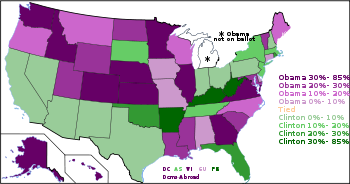Results of the 2008 Democratic Party presidential primaries
The contests are held in each of the fifty U.S. states, as well as the District of Columbia, Puerto Rico, American Samoa, Guam, the U.S. Virgin Islands, and Democrats Abroad.
In order to secure the nomination at the convention, a candidate must receive at least 2,117 votes from delegates (a simple majority of the 4,233 delegate votes, bearing in mind half-votes from Florida, Michigan, Democrats Abroad and the territories of Guam, American Samoa, and the U.S. Virgin Islands).
At the time of Hillary Clinton's suspending her campaign early on June 7, 2008, the superdelegate count was 246½ for her, and 478 for Barack Obama, with 99 still uncommitted[1] of the 823½ total then existing.
[2] The following table summarizes the results of the local contests below, thus providing a nationwide overview of the nomination process.
These statements must be read with the sort of close grammatical and definitional care that used to inform her husband’s descriptions of his personal entanglements.
They are not quite true in the normal sense, but if made under oath they would not be prosecutable for perjury, either.This section reports popular vote data for the two leading candidates, Barack Obama and Hillary Clinton.
News media frequently report the popular vote on election night, declaring states "won" on this basis.
However, the math behind this claim relied upon a number of points that were disputed by neutral political observers and by the Obama campaign.
However, turnout is generally lower in caucuses, and as a result, the popular vote may overweight the influence of primary states.
[13] Thus, some researchers argue that the popular vote underestimates the depth of Obama's support in caucus states.
[15] If these states were to hold primaries and Obama were to win by a similar margin, his popular vote total would be considerably higher.
[17] These results do not record the preferences of voters who chose to stay home, believing that their votes would not count.
House Speaker Nancy Pelosi has said that the popular vote should have no effect under the current rules: "It’s a delegate race.
"[19] Nevertheless, polls have shown that a plurality of Democrats think superdelegates should consider the popular vote when deciding which candidate to support.





